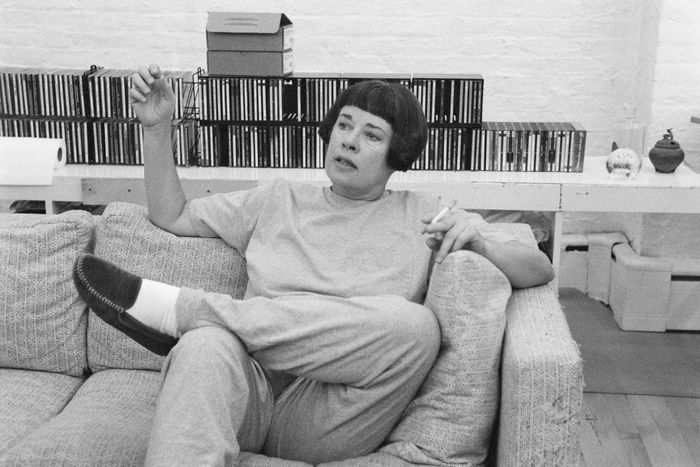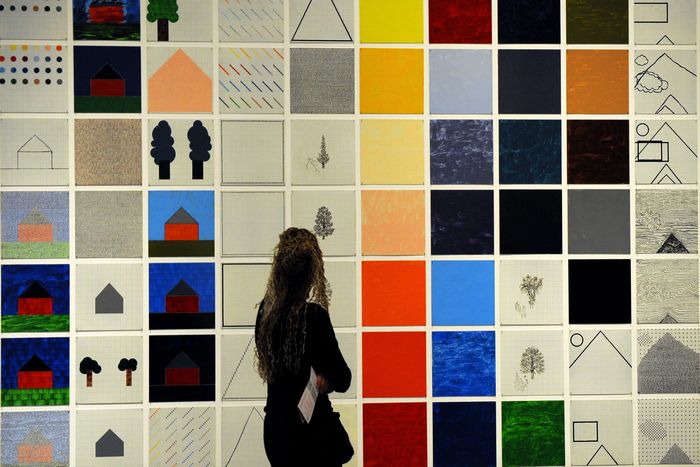
In May 1976, Jennifer Bartlett, who died this week at the age of 81, blew the art worldÔÇÖs mind when she showed her gigantic 987-paneled wraparound painting Rhapsody at Paula CooperÔÇÖs gallery in Manhattan. The panels were enamel-painted steel plates, installed grid-style, with some panels standing as individual images and others combining to form a larger image. Rhapsody was a visually voluptuous, parade float of a work; it also planted a stake in the heart of all those then pontificating about paintingÔÇÖs rumored death.
Rhapsody was a phantasmagoria of different abstractions. It was a nascent manifestation of New Image painting, a prefiguring of neo-Expressionism, and a consolidation of a decade of feminist art, whose practitioners included Elizabeth Murray, Susan Rothenberg, Lynda Bengalis, Howardena Pindell, Jackie Winsor, Pat Stier, Joan Snyder, and others. It was one of the formative big bangs of the second part of the 20th century, on par with Meret OppenheimÔÇÖs fur-lined teacup in signifying a new graphic field of thought.
The chief critic for the New York Times, John Russell, called it ÔÇ£the most ambitious single work of new art that has come my way since I started to live in New York.ÔÇØ In these pages, Kay Larson wrote Bartlett was ÔÇ£one of the two strongest painters of the post-minimal generationÔÇØ (the other was Elizabeth Murray). My wife wrote a whole book about Rhapsody. In the same way Frederick ChurchÔÇÖs huge sublime landscapes traveled around the country, BartlettÔÇÖs optical wunderkammer went on to be exhibited more than a dozen times in the U.S. following its debut, in various configurations depending on the space. Always to crowds.
Bartlett said she wanted to make a work that had everything in it. It felt that way at the time, like it was exploiting every aesthetic source and creating all these visual intensities and dichotomies. Bartlett said Rhapsody was supposed to be like a conversation  in which people digress from one thing and maybe come back to the subject, then do the same with the next thing. This made me see her work as a form of linear Cubism, in the ways that planes seem to stop, start, resume, and change modes all on one surface. That was what Rhapsody was doing in my head. It was simultaneously landscape, object, and map. It was beautiful and alive, cartoonish and historical, a type of kaleidoscopic consciousness.
The work has seven thematic sections: Introduction, Mountain, Line, House, Tree, Shape, and Ocean. There are parts with patterns, others with geometric shapes, some with recognizable images of nature, and other others with Sol LeWittÔÇôlike abstraction. Rhapsody became this Great Barrier Reef of forms, color, and shape. There were protoplasmic flickers, changing gravitational fields, dots, camouflage patterns, mosaics that moved like eels, rock crystals, all lit up. It was as if life was mutating in logical and illogical sequences, metabolizing before your eyes, pressing against the edges of panels or sometimes propagating into adjoining panels so that the whole thing was a continuous alien mycelium form.
Bartlett wrote a novel called History of the Universe. I remember reading it in the 1980s and being dazzled by its drive and force. I think it was about her, or her work, or about everything. Her mind and art were encyclopedic. I interviewed her a few times, and each time came away sort of breathless. I was a little afraid of her sometimes, like she had X-ray vision on the one hand or could be blind to what was going on around her. My wife and I visited her in Paris in her apartment. I recall having to rest in the Luxembourg Gardens afterward; I was so exhausted from her energy and talk. Her homes in New York were big; one had an indoor swimming pool. Bartlett thought, painted, and lived large.
The pulsing aesthetic glow of Rhapsody was always in the background of her career, but I paid attention to everything she made afterward, including a 24-part series based on the hours of the day and installations of beach scenes with actual rowboats. When she was great, she was epically great, and always unafraid to reach for more. Her artistic tree of life is still in bloom for me.


